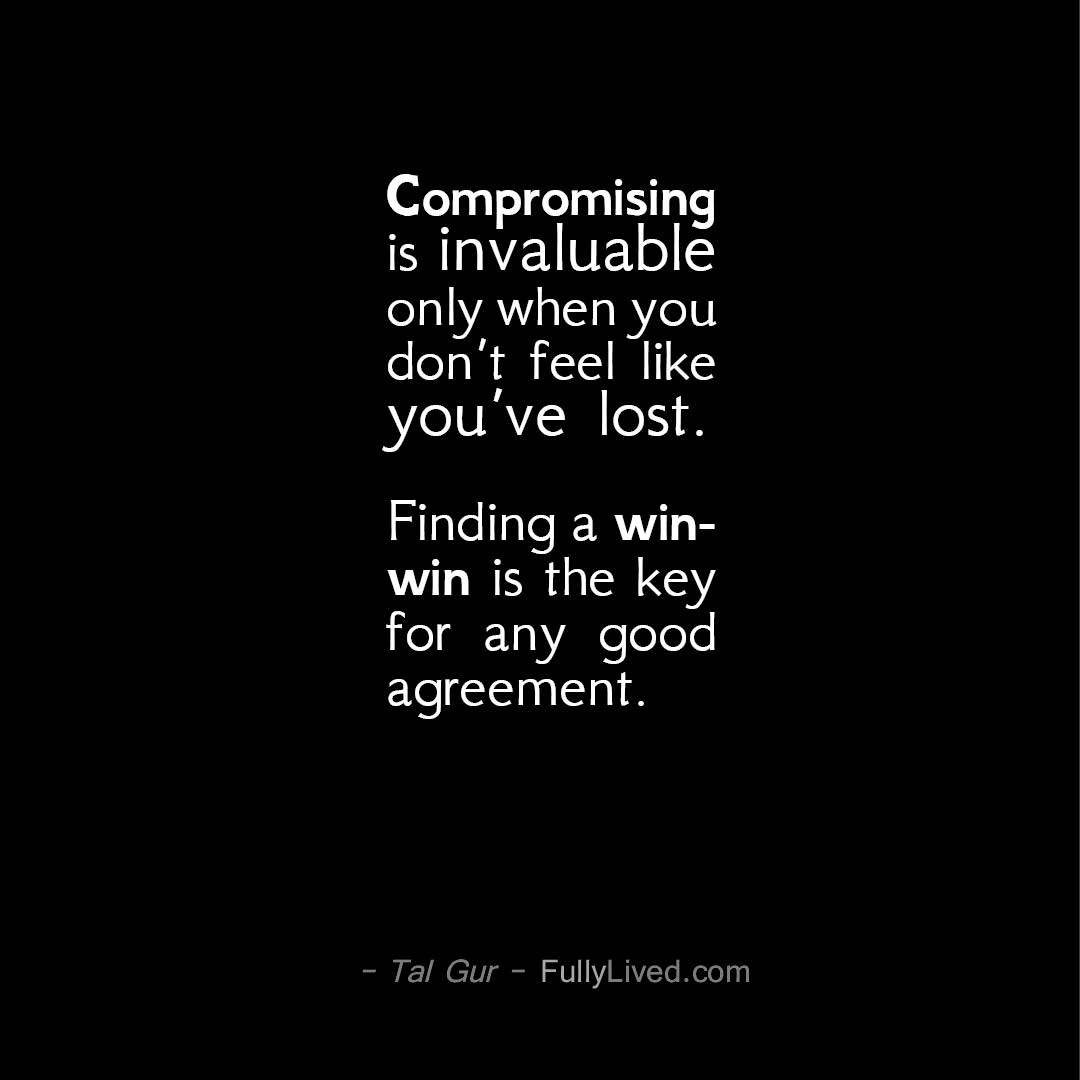Compromising is invaluable only when you don’t feel like you’ve lost. Finding a win-win is the key for any good agreement.
Imagine you're navigating a vast ocean, your destination set on the horizon, but the waters are tumultuous, and the winds are unpredictable. In such moments, compromise becomes your compass, guiding you through the storm to calmer seas. Yet, it's not merely about yielding until you feel defeated. No, true compromise is a delicate dance where both parties find themselves better off, where the outcome isn't a bitter pill but a sweet victory for all involved.
Think of compromise as a recipe for harmony in the symphony of life. Just as a chef balances flavors to create a delectable dish that satisfies all palates, compromise blends the desires and needs of individuals to craft a solution that leaves everyone feeling fulfilled. It's not about sacrificing your own happiness for the sake of others nor steamrolling over their desires to achieve your own agenda. Instead, it's about synergizing, harmonizing, and creating something greater than the sum of its parts.
Consider a negotiation as a puzzle waiting to be solved. Each piece represents a different viewpoint, a diverse set of interests, and when put together thoughtfully, they form a cohesive picture of mutual benefit. Compromise isn't about discarding pieces or forcing them into places they don't fit; it's about arranging them in a way that brings out the beauty of the whole image. Just as a puzzle is incomplete without every piece, so too is a negotiation without considering all perspectives.
Picture a seesaw in a playground, with compromise acting as the fulcrum. If one end bears all the weight while the other remains aloft, there's imbalance, dissatisfaction, and ultimately, a collapse. But when both ends find equilibrium, rising and falling in tandem, there's joy in the shared experience. Compromise, then, becomes the stabilizing force that keeps relationships, whether personal or professional, from toppling over.
Consider a garden where different plants coexist, each requiring varying amounts of sunlight, water, and nutrients. Compromise, in this context, is like tending to the garden, ensuring that each plant receives what it needs to thrive without overshadowing or suffocating its neighbors. Just as the gardener balances competing needs to cultivate a flourishing ecosystem, so too must individuals navigate the landscape of compromise to nurture healthy relationships and agreements.
Think of compromise as a bridge connecting two shores separated by a chasm of differences. Without compromise, each side remains isolated, unable to traverse to the other's perspective. But with compromise, the bridge emerges, allowing passage for understanding, empathy, and cooperation. It's not about erasing differences but building connections strong enough to withstand the weight of divergent viewpoints.
Imagine a tapestry woven from threads of different colors and textures. Each thread represents a unique perspective, a distinct voice in the fabric of society. Compromise, then, is the skilled hand that weaves these threads together, creating a tapestry that is not only beautiful but also resilient. Just as a tapestry gains strength from its interwoven threads, so too does society flourish when individuals embrace compromise as the fabric of civic discourse.
In every aspect of life, from personal relationships to global politics, the art of compromise is essential for progress, peace, and prosperity. It's the difference between stagnation and growth, between conflict and resolution, between discord and harmony. So, the next time you find yourself at odds with another, remember that compromise isn't about giving in or giving up; it's about finding common ground, forging connections, and moving forward together.
Now, consider this: In what areas of your life could you practice compromise more effectively to create better outcomes for yourself and those around you?
*To obtain more inspiration and motivation to achieve your goals, you definitely want to check out my extensive list of growth goals. This page contains SMART goal ideas that can help you establish new aspirations and attain greater heights in your personal growth journey. I utilized this page myself to create my own list of 100 life goals, which I dedicated a decade to pursuing.
Chief Editor
 Tal Gur is an author, founder, and impact-driven entrepreneur at heart. After trading his daily grind for a life of his own daring design, he spent a decade pursuing 100 major life goals around the globe. His journey and most recent book, The Art of Fully Living, has led him to found Elevate Society.
Tal Gur is an author, founder, and impact-driven entrepreneur at heart. After trading his daily grind for a life of his own daring design, he spent a decade pursuing 100 major life goals around the globe. His journey and most recent book, The Art of Fully Living, has led him to found Elevate Society.























